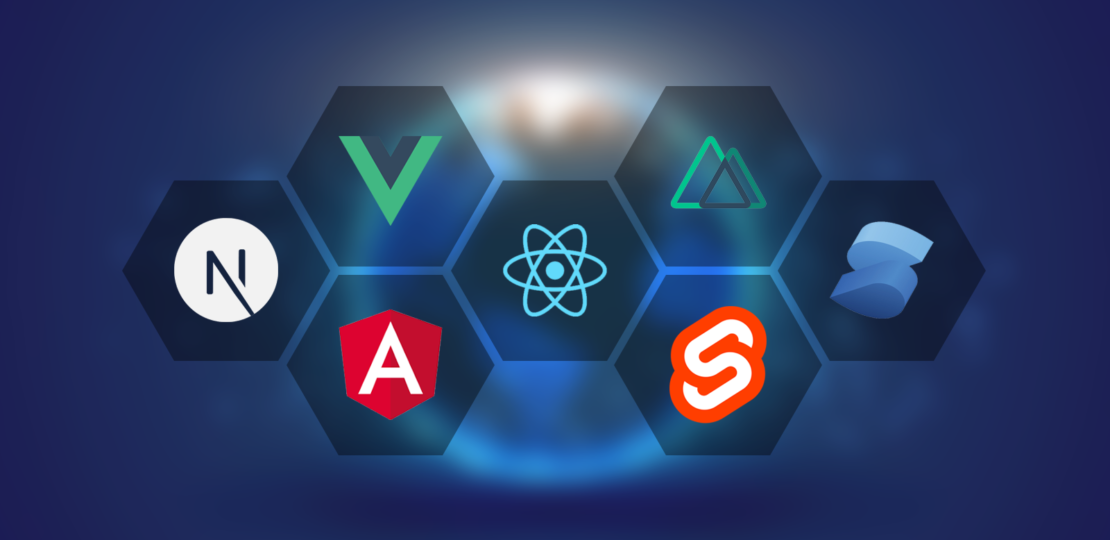
In the rapidly evolving world of web development, staying updated with the latest front-end frameworks is key to building fast, responsive, and visually appealing websites. As we step into 2024, developers are focusing more on frameworks that offer improved performance, scalability, and seamless integration with modern tools and technologies. Whether you’re a seasoned developer or just starting out, choosing the right framework can significantly impact your productivity and project outcomes. In this post, we’ll explore the top front-end frameworks of 2024 that are shaping the future of web development and overview what makes them stand out in today’s competitive landscape.
1. React.JS
Overview: Developed by Facebook, React remains one of the most popular front-end libraries in 2024. Its component-based architecture and virtual DOM enable developers to build fast, dynamic, and scalable applications. React has a vast ecosystem of tools and libraries, and its large community ensures continued growth and improvement.
- Key Features:
- Component-based architecture
- Strong ecosystem (React Router, Redux, etc.)
- Fast rendering with the virtual DOM
- Excellent integration with third-party libraries
- React Native for mobile development
Use Cases: Single-page applications (SPAs), large-scale applications, and dynamic user interfaces (UIs).
2. Vue.js
Overview: Vue.js has gained immense popularity due to its simplicity and ease of integration. In 2024, Vue continues to be favored by developers looking for a lightweight and flexible framework. Vue’s progressive framework allows developers to adopt it incrementally, making it a great option for both small and large applications.
- Key Features:
- Two-way data binding
- Virtual DOM
- Reactive components
- Seamless integration with other libraries
- Excellent documentation and ease of learning
Use Cases: SPAs, progressive web apps (PWAs), and cross-platform applications.
3. Angular
Overview: Backed by Google, Angular is a full-fledged front-end framework that provides everything a developer needs to build complex, enterprise-level applications. With TypeScript at its core, Angular has a steep learning curve but offers excellent scalability and performance.
- Key Features:
- Two-way data binding
- Dependency injection
- Built-in routing and form handling
- TypeScript support
- Component-based architecture with services
Use Cases: Enterprise-grade applications, complex web apps, and applications requiring strong maintainability.
4. Svelte
Overview: Svelte has taken a unique approach in the front-end world by shifting much of the work to compile-time, resulting in minimal runtime code. This leads to faster load times and smaller bundles, making Svelte an exciting choice for performance-focused applications.
- Key Features:
- No virtual DOM (compile-time magic)
- Minimal bundle size
- Reactive, component-based framework
- Out-of-the-box reactivity without extra libraries
Use Cases: Performance-critical apps, SPAs, and static websites.
5. Next.js
Overview: Built on top of React, Next.js has become the go-to framework for server-side rendering (SSR) and static site generation (SSG). In 2024, Next.js is leading the way for developers aiming for SEO-friendly and fast-loading websites, thanks to its hybrid rendering capabilities.
- Key Features:
- Server-side rendering (SSR) and static site generation (SSG)
- API routes for server-side logic
- Built-in routing and file-based routing
- Excellent performance and SEO optimizations
Use Cases: SSR apps, e-commerce platforms, and content-heavy websites.
6. Nuxt.js
Overview: Nuxt.js is the Vue.js equivalent of Next.js, offering server-side rendering, static site generation, and an intuitive framework for building Vue-based applications. Nuxt.js is especially popular for building SEO-friendly websites with Vue.
- Key Features:
- SSR and SSG support
- File-based routing
- Modular structure with extendable configurations
- Vue 3 support and great community plugins
Use Cases: SSR apps, e-commerce, and Vue-based SEO-friendly websites.
7. Qwik
Overview: Qwik is a newcomer in 2024 that focuses on instantly loadable applications, optimizing for the fastest possible startup. It allows developers to create apps that boot in milliseconds by leveraging “resumability” rather than rehydration.
- Key Features:
- Instantly interactive with no hydration
- Fine-grained lazy loading
- Reactive and component-based
- Zero JavaScript execution on page load
Use Cases: Ultra-fast SPAs, e-commerce, and performance-focused applications.
8. Solid.js
Overview: Solid.js has grown significantly in 2024 due to its fine-grained reactivity and high-performance rendering. It offers the same developer experience as React but focuses on reducing overhead by avoiding the virtual DOM.
- Key Features:
- Fine-grained reactivity
- No virtual DOM
- Tiny bundle size
- Focus on performance and efficiency
Use Cases: Performance-critical apps, real-time apps, and interactive UIs.
9. Ember.js
Overview: Ember.js continues to be a powerful framework for building ambitious web applications in 2024. With a strong convention-over-configuration approach, Ember.js helps developers maintain best practices and build scalable apps.
- Key Features:
- Strong convention-over-configuration approach
- Built-in routing and state management
- Two-way data binding
- Robust CLI for building apps
Use Cases: Large-scale applications, SPAs, and long-term maintainable projects.
10. Alpine.js
Overview: Alpine.js is a lightweight framework that offers the power of modern frameworks without the complexity. It’s similar to Vue but designed for simpler tasks and minimal interactivity. It’s often used for enhancing existing UIs without the need for a full framework.
- Key Features:
- Lightweight and easy to integrate
- Declarative, component-driven UI development
- Minimal footprint, only adds interactivity when needed
- No build steps required
Use Cases: Small-scale apps, adding interactivity to static websites, and enhancing UIs.
RELATED POSTS
View all

